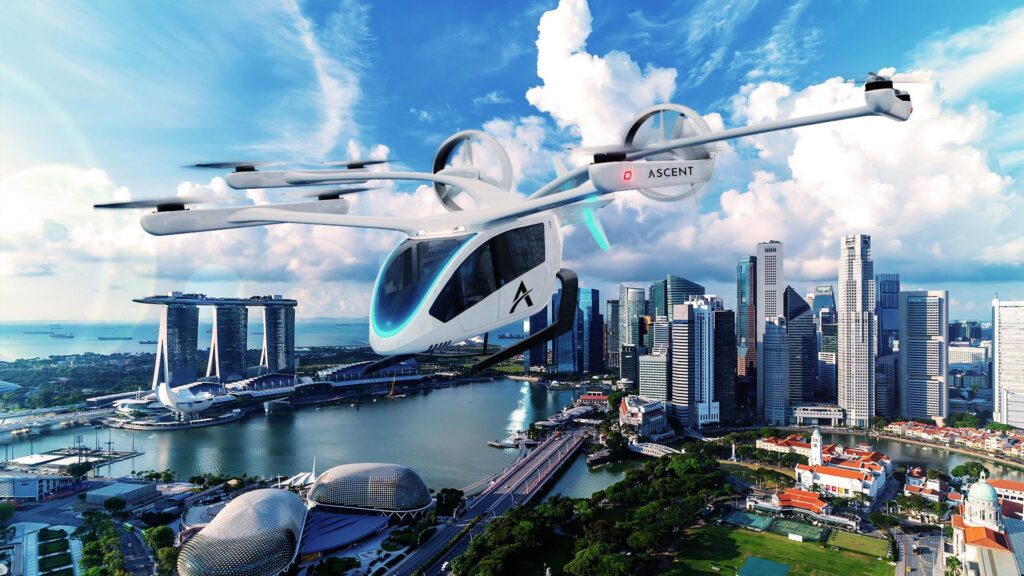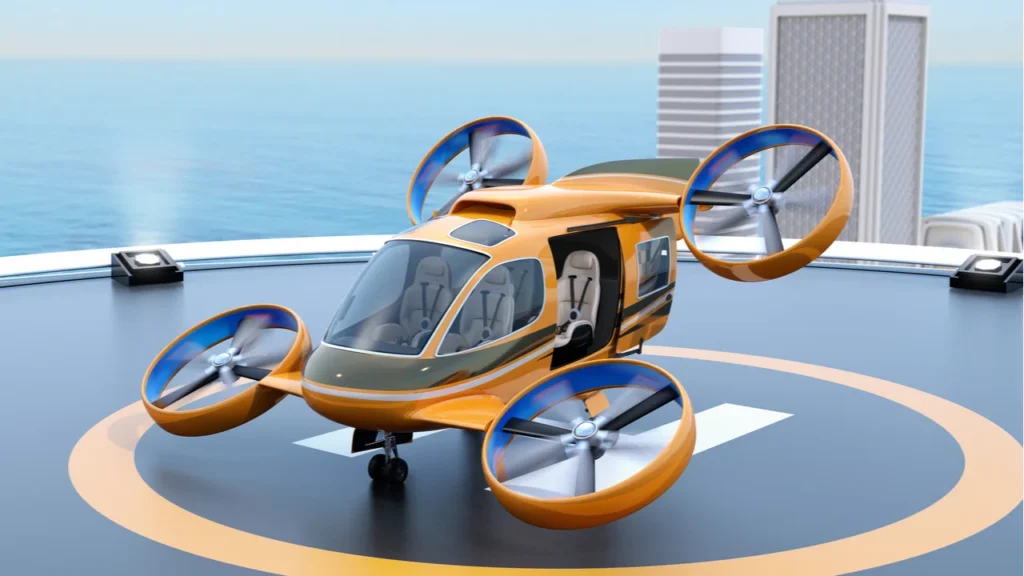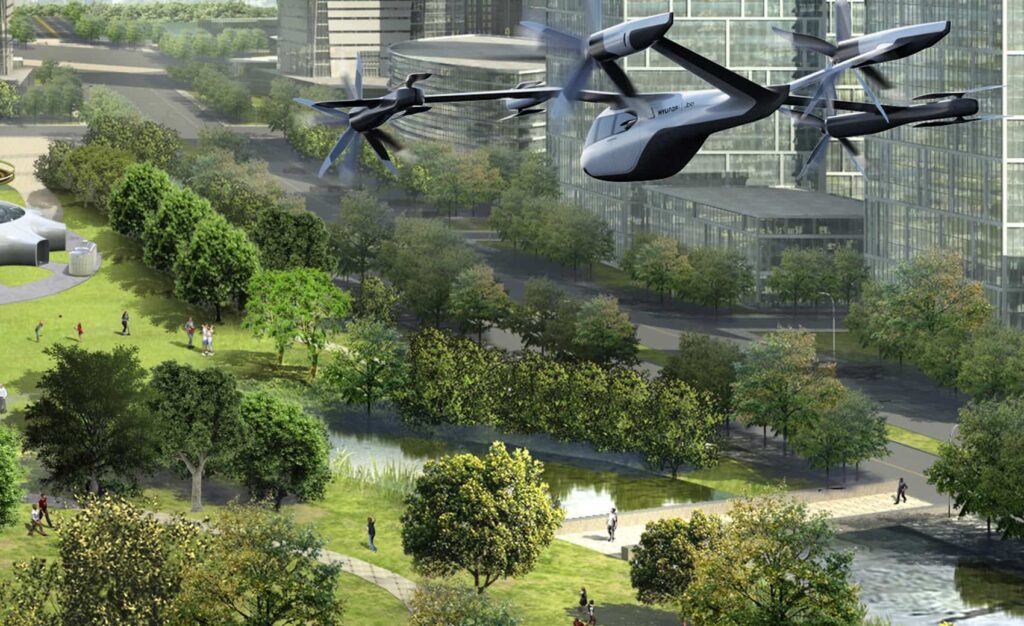
Urban Air Mobility (UAM) and Advanced Air Mobility (AAM) are set to transform the way we move around cities, introducing new forms of air transportation that were once the stuff of science fiction. With the rise of air taxis, flying cars, and electric aircraft, UAM is becoming a reality, offering faster, more environmentally friendly alternatives to ground transportation. In this post, we’ll explore the future of UAM and AAM, the benefits of electric aircraft and air taxis, the challenges we face, and what the future holds for this exciting new frontier.
What is Urban Air Mobility (UAM) and Advanced Air Mobility (AAM)?
Urban Air Mobility (UAM) refers to the use of electric vertical takeoff and landing (eVTOL) aircraft, also known as air taxis, to transport people and goods within urban environments. These electric aircraft are quieter, more efficient, and more sustainable than traditional helicopters or airplanes.
Advanced Air Mobility (AAM) takes the concept of UAM even further, expanding the reach of air transportation to regional and rural areas. While UAM focuses on intra-city travel, AAM aims to connect cities and regions, making flying cars, unmanned aircraft systems, and air taxis a central part of the future transportation network.
What are Air Taxis and Flying Cars?
Air taxis are small, electric aircraft designed for short-range urban flights, providing an alternative to traditional ground transport. Flying cars, while still in development, are expected to offer both ground and air travel capabilities, blurring the lines between personal vehicles and aircraft. Both innovations fall under the umbrella of UAM and AAM, promising faster, more flexible travel options.
Key Benefits of UAM and Air Taxis
1. Reduced Traffic Congestion
One of the most significant benefits of UAM aircraft is the ability to reduce ground traffic congestion by utilizing the airspace above cities. With the introduction of air taxis and electric aircraft, city streets could see a reduction in vehicles, leading to faster commutes and less congestion.
2. Faster and More Efficient Travel
By offering direct, point-to-point transportation, air taxis and eVTOL aircraft can significantly reduce travel times across congested cities. Imagine skipping traffic and arriving at your destination in minutes rather than hours. UAM aircraft make this possible, providing a faster alternative to traditional vehicles.
3. Environmental Impact
Electric aircraft and flying cars run on electric propulsion systems, offering a much greener alternative to traditional aircraft. The reduction in fuel use and emissions contributes to a more sustainable urban environment. Air taxis, in particular, could become a key player in reducing urban pollution.
4. Expanding Regional Connectivity
Advanced Air Mobility (AAM) goes beyond city limits, connecting urban areas with regional and rural destinations. This expanded network will make air transportation more accessible, offering new opportunities for regional development and improving the convenience of inter-city travel.
Challenges in Developing UAM Aircraft and Electric Aircraft

While the future of UAM and AAM is exciting, there are several challenges that must be addressed before air taxis and flying cars become a mainstream mode of transportation.
1. Regulation and Certification for Unmanned Aircraft Systems
Developing a regulatory framework for unmanned aircraft systems, air taxis, and electric aircraft is a complex challenge. Governments and aviation authorities will need to create new policies that ensure safety, manage low-altitude airspace, and certify UAM aircraft for public use.
2. Infrastructure for Air Taxis and Flying Cars
UAM infrastructure will require the development of vertiports—specialized landing and takeoff areas for eVTOLs and air taxis. These vertiports will need to be strategically located throughout urban areas to integrate with existing transportation hubs like airports, train stations, and public transit systems.
3. Public Trust and Safety
Operating UAM aircraft in urban areas raises safety concerns, especially with unmanned aircraft systems. Public acceptance will depend on the ability of these new technologies to operate safely in complex, crowded environments. Robust safety systems, including collision avoidance and air traffic management, will be essential.
4. Noise and Privacy Issues
Although quieter than helicopters, UAM aircraft still produce noise. Managing noise pollution and ensuring privacy for city residents will be key considerations in the development of UAM and AAM networks.
Industry Landscape: Flying Cars, eVTOLs, and Air Taxis
The UAM industry is attracting investment and innovation from established aerospace companies and cutting-edge startups alike. Electric aircraft, unmanned aircraft systems, and air taxis are at the forefront of this movement.
Leading Players in UAM and AAM:
- Joby Aviation: Known for their work on eVTOL aircraft and air taxis, Joby is one of the most recognized names in UAM.
- Volocopter: A German company leading the development of air taxis with an emphasis on sustainability and safety.
- Archer Aviation: A U.S.-based company focusing on air taxis that are both efficient and affordable for the public.
- EHang: A Chinese firm specializing in autonomous unmanned aircraft systems and electric aircraft designed for urban transportation.
Market Growth Projections
The global UAM market is expected to grow significantly, with a predicted 25% CAGR between 2024 and 2044. This growth is driven by advancements in electric aircraft technology, urbanization, and the increasing demand for sustainable transportation options.
The Future of Air Transportation and UAM

The path forward for Urban Air Mobility and Advanced Air Mobility will require collaboration between governments, the private sector, and the public. To ensure the success of UAM, the following steps will be crucial:
1. Regulatory Frameworks for Unmanned Aircraft Systems
Governments and aviation authorities must work together to create comprehensive regulations for unmanned aircraft systems, air taxis, and flying cars. This includes safety protocols, airspace management, and certification standards.
2. Technological Advancements in Electric Aircraft
Improvements in battery technology, electric propulsion systems, and aircraft design will be necessary to make UAM more efficient and accessible. Continued innovation will help reduce the costs of flying cars and electric aircraft, making them more viable for widespread use.
3. Public Engagement and Trust
Public education campaigns will be essential to gaining acceptance for UAM. Addressing concerns around safety, noise, and privacy will help build trust and encourage the adoption of air taxis, flying cars, and electric aircraft as part of everyday transportation.
Conclusion
Urban Air Mobility and Advanced Air Mobility are poised to revolutionize how we move within and between cities. With the rise of air taxis, flying cars, and electric aircraft, the future of air transportation looks faster, cleaner, and more efficient. However, to make UAM a reality, challenges like infrastructure development, regulation, and public acceptance must be addressed. As these hurdles are overcome, we can expect UAM and AAM to become integral parts of our transportation ecosystem.
Frequently Asked Questions (FAQ)
Q: What is an air taxi?
A: An air taxi is a small, electric aircraft designed to transport passengers across short distances within urban environments, bypassing ground traffic.
Q: How do flying cars work?
A: Flying cars are hybrid vehicles that can operate both on the ground and in the air. While still in development, they are expected to play a major role in urban transportation.
Q: Are electric aircraft environmentally friendly?
A: Yes, electric aircraft produce fewer emissions compared to traditional airplanes, making them a greener alternative for air transportation.
Q: What are vertiports?
A: Vertiports are specialized landing and takeoff areas for eVTOLs and air taxis, designed to integrate with urban transportation infrastructure.